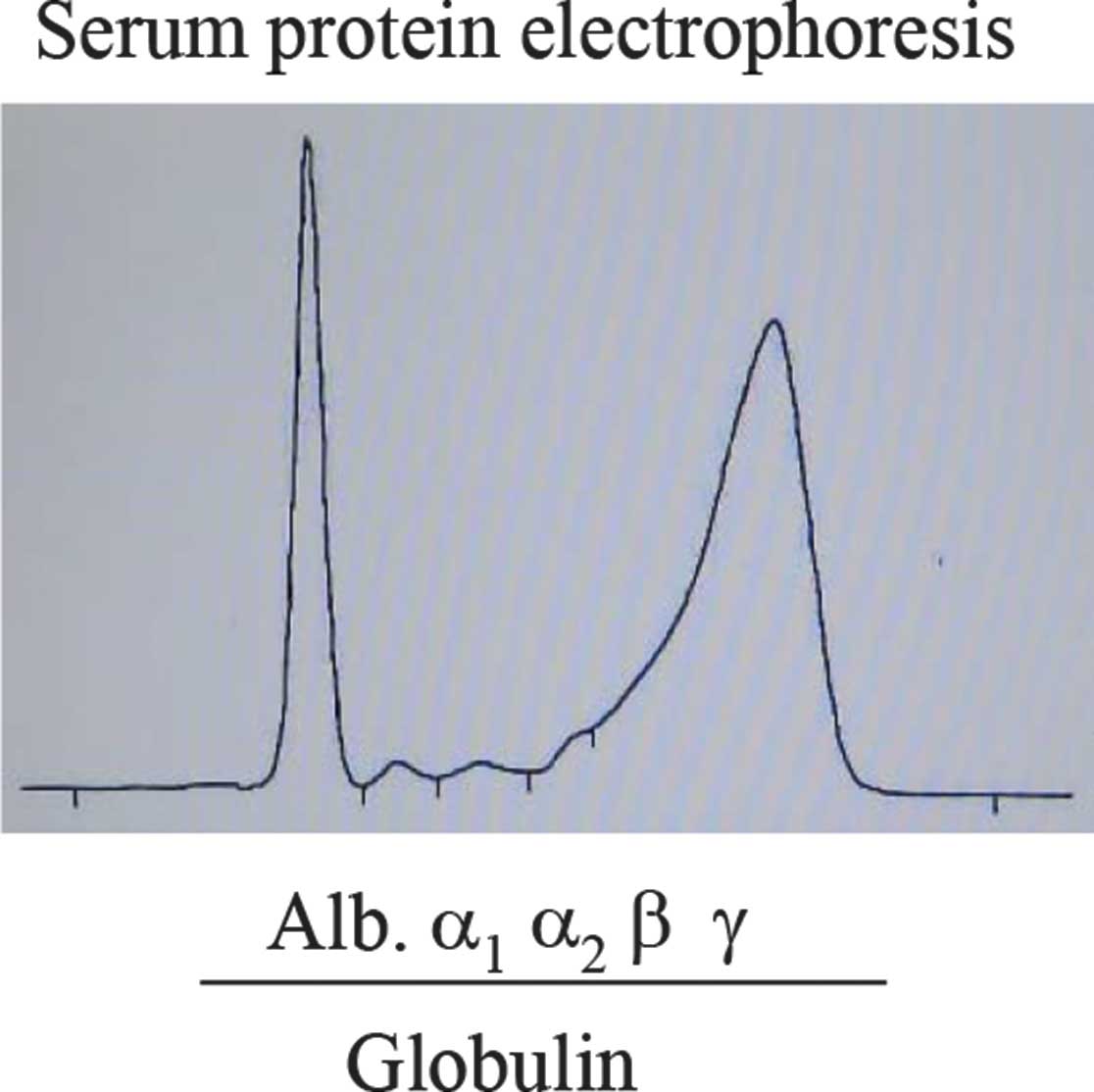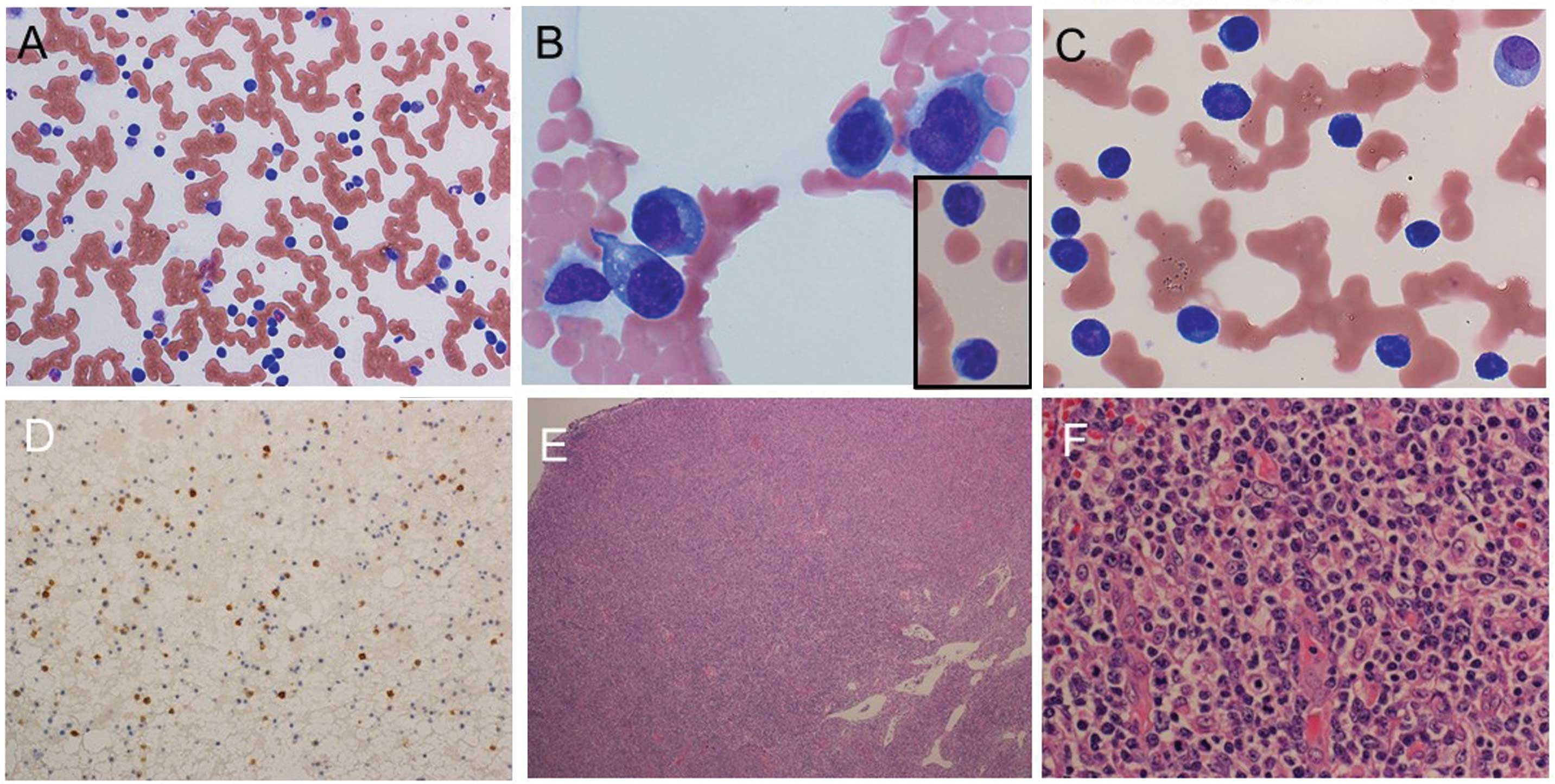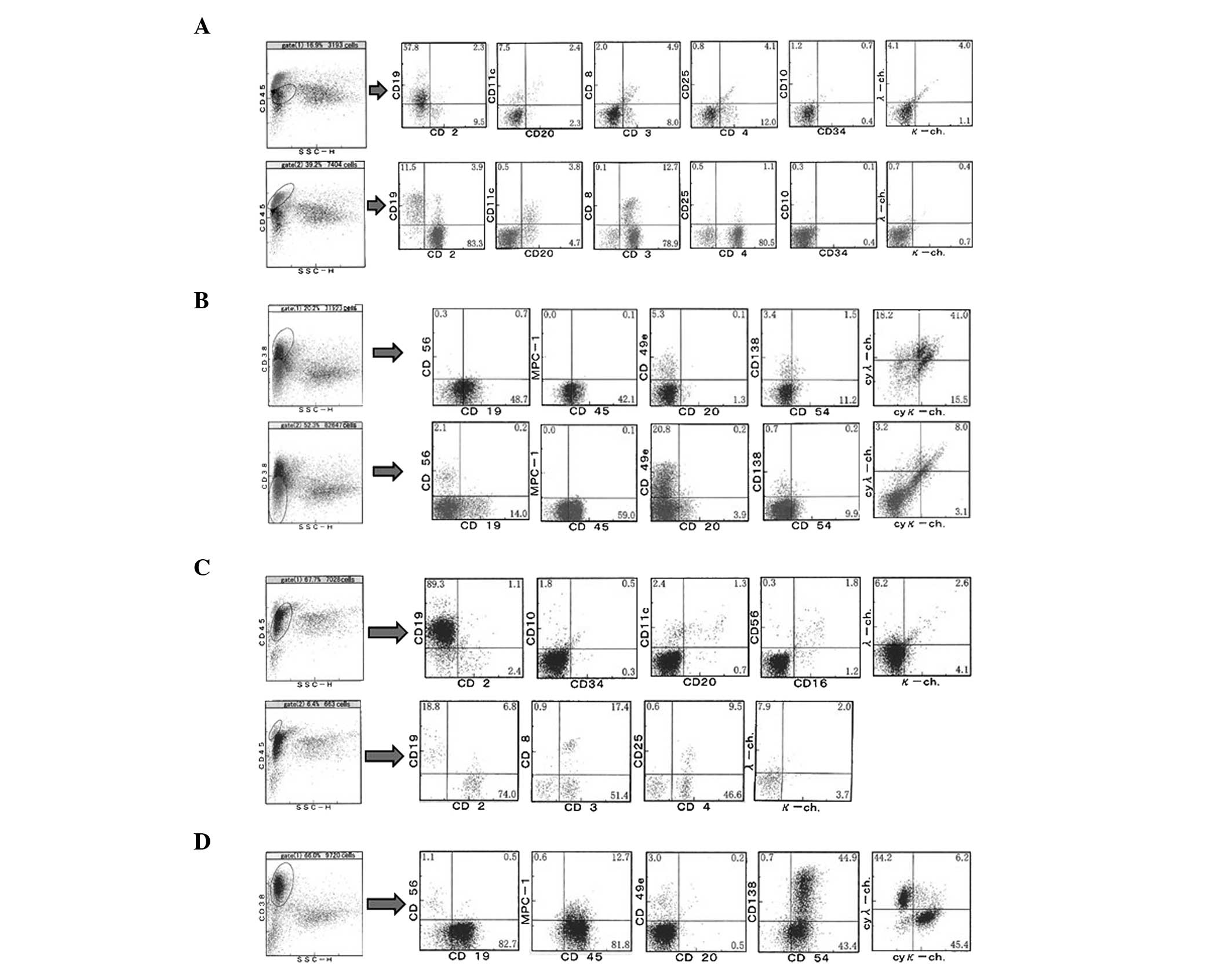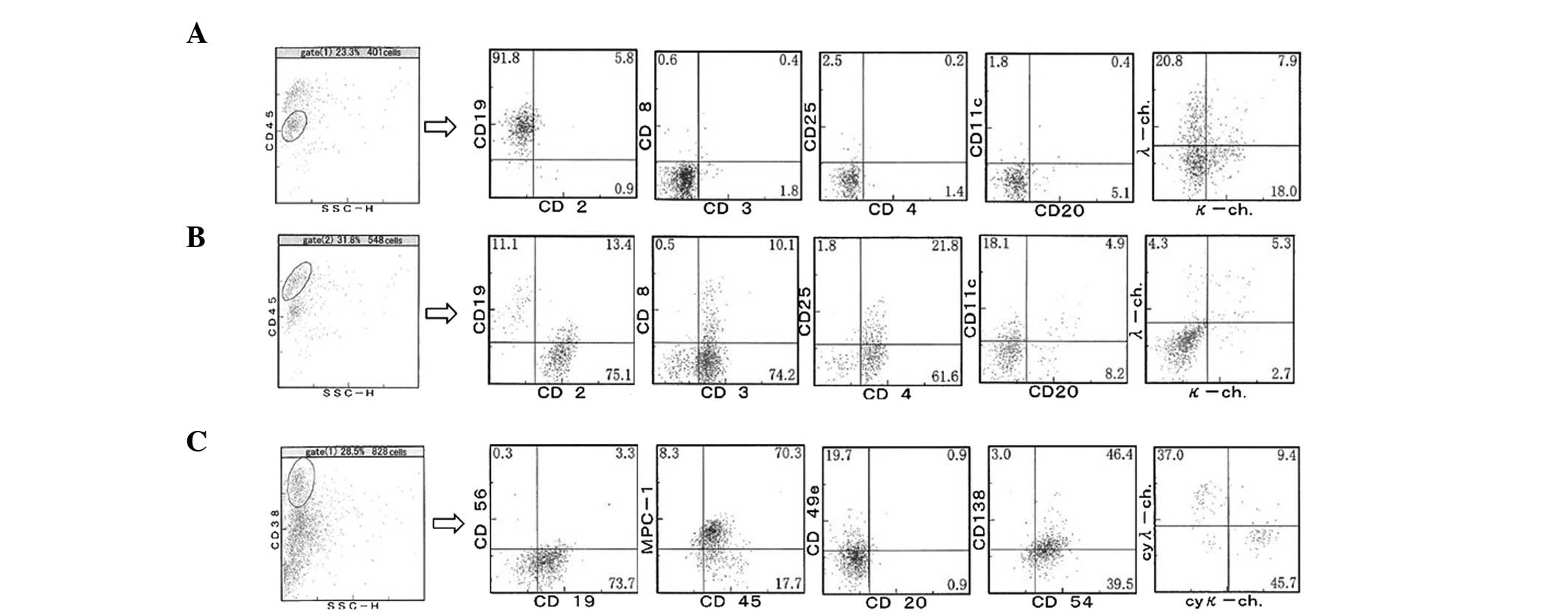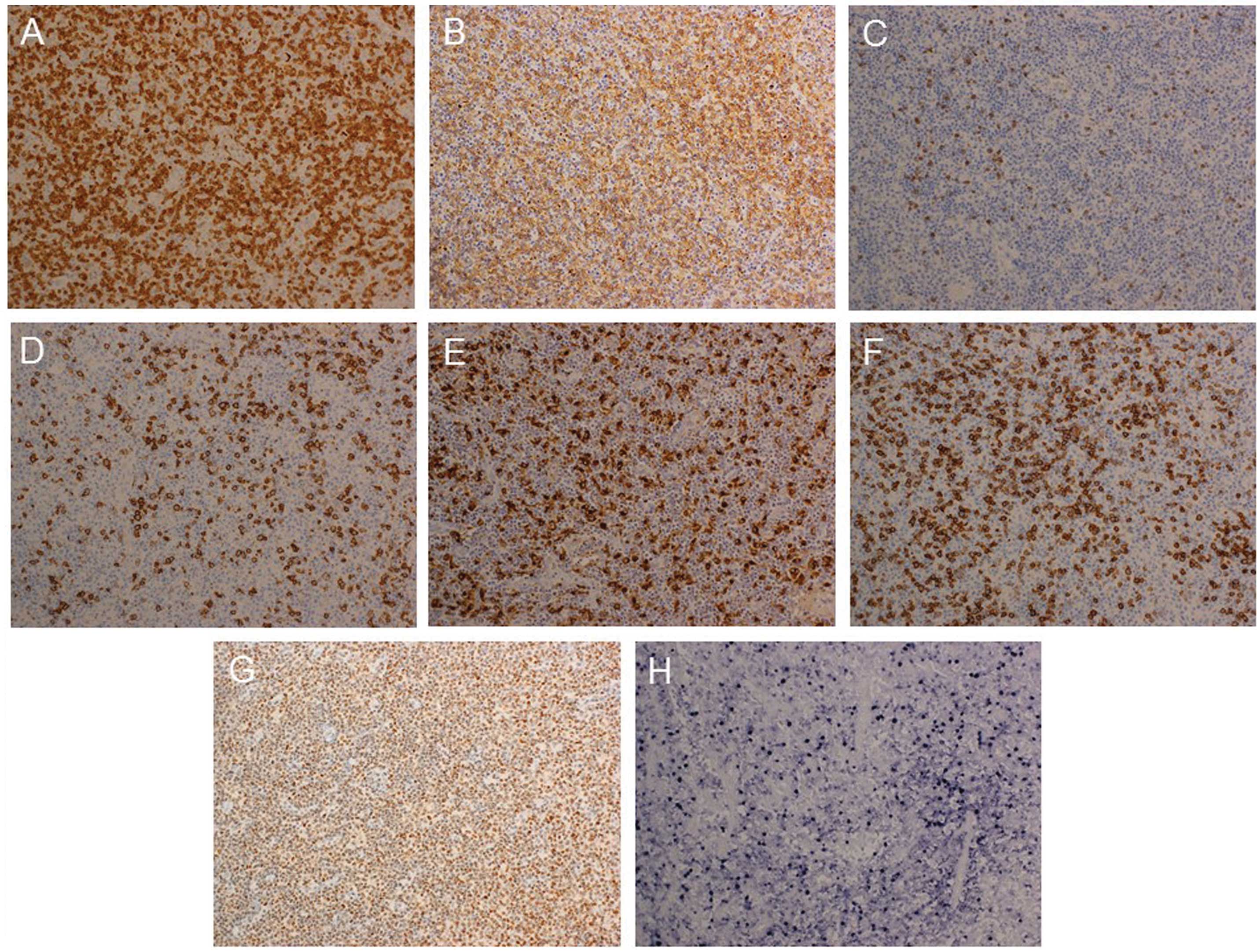A case of CD10-negative angioimmunoblastic T cell lymphoma with leukemic change and increased plasma cells mimicking plasma cell leukemia: A case report
- Authors:
- Published online on: July 14, 2015 https://doi.org/10.3892/ol.2015.3490
- Pages: 1555-1560
Abstract
Introduction
AITL is the second most frequent subtype of peripheral T cell lymphoma in the Western world, accounting for ~25–30% of peripheral T cell lymphoma cases and 2–4% of all cases of lymphoma (1). It has been reported that AITL presents with a number of clinical symptoms, including fever, weight loss, chills, skin rashes, pruritis, lymphadenopathy, hepatosplenomegaly, anemia, thrombocytopenia and hypergammaglobulinemia (2). Patients with AITL, frequently exhibit anemia, thrombocytopenia and lymphopenia in the peripheral blood. However, it is rare for patients with AITL to have numerous plasma cells in the peripheral blood, which is a feature more typical of plasma cell leukemia (3–5). The current report presents a case of a patient with AITL, in whom leukemic change and plasmacytosis were observed in the peripheral blood, bone marrow and lymph nodes.
Case report
A 78-year-old male was admitted to hospital, due to systemic lymph node swelling and an elevated number of white blood cells in comparison with normal levels, which had been detected by his family doctor 10 days previously. Upon physical examination, lymph nodes in the cervical region, supraclavicular fossa, axillary fossa and inguinal fossa were found to be enlarged to 40 mm. The peripheral white blood cell count was elevated and numerous plasmacytoid cells without dysmorphic features, in addition to small-to-medium-sized lymphoid cells with atypical nuclei, were observed in his peripheral blood, as shown in Table I, Fig. 1 and Fig. 2A and B. ‘Other’ in the leukocyte classification in Table I, includes plasmacytoid cells (19% of whole white blood cells) and lymphoid cells with nuclear atypia (22% of whole white blood cells). Anemia and low platelet numbers were also observed. Rouleaux formation was noted in the peripheral blood, suggesting the occurrence of hyperviscosity syndrome, which is likely to have been due to hypergammaglobulinemia (Fig. 2A).
Biochemical examination demonstrated a coagulation abnormality, suggesting disseminated intravascular coagulation, with high levels of γ-globulin without M-peak, immunoglobulin G (IgG), IgA, lactate dehydrogenase, C-reactive protein, β2-microglobulin, interleukin 2-receptor (IL-2R) and IL-6.
Flow cytometric analyses of the patient's peripheral blood demonstrated the CD45low population, including blastic cells, to comprise 16.9% of nuclear cells, while the CD45high lymphoid cell population comprised 39.2%, as shown in Fig. 3A. Usually, B cells in the peripheral blood express both CD19 and CD20. However, of the CD45low population, there were lots of CD19+CD20− cells and these cells did not express the Ig light chain, indicating that the population included plasma cells or extremely immature B lineage cells. In addition, there was a marked elevation in the number of CD38+ cells without MCP-1 expression, which formed ~20% of the peripheral blood nuclear cells, as shown in Fig. 2B, suggesting an increase in immature plasma cells in the peripheral blood. These results were consistent with the complete blood counts (CBC; Table I), which showed that 19% of the whole white blood cells were plasmacytoid cells.
Within the CD45high population, the number of CD4+CD3+ cells made up ~30% of peripheral nuclear cells, which were negative for CD10. The CD4:CD8 ratio was ~6:1, and the majority of the CD4+ cells did not express CD25. As noted, the percentage of small-to-medium-sized lymphoid cells with atypical nuclei had increased to ~22% in the peripheral blood, suggesting that cells exhibiting this increase may be CD4+CD10−CD25− T cell lymphoma/leukemia cells.
Enhanced computerized tomography demonstrated splenomegaly and splenic infarction (data not shown).
Upon examination of the bone marrow, the CD45low population, including blastic cells, was 67.7%, and 89.3% of these were CD19+. However, the CD19+ cells expressed neither CD20 nor surface Ig light chain (Fig. 3C). As shown in Fig. 3D, CD38+ cells made up 66% of the bone marrow nuclear cells. Of CD38+ cells, 13.3% were MPC-1+, 45.6% were CD138+ and 95.8% were intracytoplasmic Ig light chain-positive, suggesting an elevation of plasma cells, particularly of immature plasma cells, in the bone marrow. These plasma cells did not exhibit clonal proliferation, since the κ:λ ratio in the Ig light chain was ~1:1. In the lymphocyte gate, ~70% of nuclear cells were T cells, and >2/3 of the T cells were CD4+. In the May-Giemsa stained smear specimens of the bone marrow, small-to-medium-sized lymphoid cells with nuclear atypia were found (data not shown). The cells were similar to the small to medium sized lymphoid cells with nuclear atypia observed in the peripheral blood.
Subsequently, biopsies of an enlarged inguinal lymph node were taken. The normal architecture of the lymph node had been replaced by variously-sized, although predominantly medium-sized, lymphoid cells with clear cytoplasm, as shown in Fig. 2E and F. High endothelial venules were prominent (Fig. 2F). Upon flow cytometric analysis, 91.8% of the CD45low population, including blastic cells, were found to be CD19+, while the majority of CD19+ cells were CD20−, and half of CD19+ cells expressed Ig light chain, although the pattern of expression of light chains did not indicate clonal expansion. In the gate of CD45high, a lymphocyte gate, 84.3% of cells were CD3+, and nearly all were CD4+ (Fig. 4B). As shown in Fig. 4C, even in the lymph node, the percentage of CD38+ cells had risen to 28.5%. These cells did not express CD20, while 77% expressed CD19, and ~50% of expressed CD138. Unlike the peripheral blood and bone marrow samples, the CD38+ cells in the lymph node sample expressed MPC-1 and CD45, suggesting an increase in mature plasma cells in the lymph node. The majority of cells expressed cytoplasmic Ig light chain, although the κ:λ ratio did not indicate clonal expansion.
Immunohistological analyses demonstrated a diffuse increase in CD138+ cells and CD3+ cells (T cells) within the lymph node specimen (Fig. 5). Among T cells, the number of CD4+ cells was markedly increased. Numerous Maf-1+ cells were observed in the lymph node, in addition to a diffuse distribution of Epstein-Barr virus (EBV)-encoded small RNA-positive cells.
In order to examine the clonal rearrangement of T cell receptor (TCR) and Ig, a PCR assay was conducted, as described in the European BIOMED-2 collaborative study (6). PCR indicated the presence of clonal rearrangements of TCR and Ig (data not shown).
Based on the histological features of the lymph node, the patient's symptoms, the increase in B-lineage cells without neoplastic light chain expression, the increase in CD4+ T cells with clear cytoplasm expressing Maf-1, and the presence of EBV-infected lymphoid cells, the patient was diagnosed with AITL with leukemic change. Following diagnosis, the patient died unexpectedly. No autopsy was permitted, and the exact cause of death therefore remains unclear, although hyperviscosity of the blood may have been a contributing factor. The family of the patient provided informed consent for the publication of this report.
Discussion
The current report discusses the case of a patient with CD10− AITL with leukemic change, plasmacytosis mimicking plasma cell leukemia and polyclonal hypergammaglobulinemia.
Examination of a lymph node biopsy demonstrated a histology typical of AITL, including completely effaced nodal architecture and the infiltration of medium-sized lymphocytes with clear cytoplasm, in addition to an inflammatory background. Furthermore, increased numbers of plasma cells and lymphoid cells with atypical nuclei were observed in the peripheral blood.
Plasma cell leukemia is defined as circulating peripheral blood plasma cells exceeding 2×109/l or 20% of peripheral white blood cells (7). In addition, the clonality of these plasma cells may be demonstrated by serum protein electrophoresis, flow cytometric analyses and/or Ig rearrangement. In the present case, 6.308×109/l and 19% of peripheral white blood cells were plasmacytoid cells. The serum γ-globulin was significantly elevated, while serum protein electrophoresis and flow cytometric analyses did not demonstrate any clonal proliferation of B-lineage cells.
The presence of plasmacytoid cells in the peripheral blood is occasionally observed during reactive processes, such as bacterial and viral infections, such as parvovirus B19, hepatitis or EBV; autoimmune disease, such as rheumatoid arthritis, systemic lupus erythematosus or Sjögren's syndrome; and serum sickness. However, in these conditions, the plasmacytoid cell counts are usually not notably elevated (8–16).
A number of cases of AITL with increased plasmacytoid cells in the peripheral blood, which is typical of plasma cell leukemia, have been reported (3–5). In these reports, the plasmacytoid cell counts in the peripheral blood were markedly elevated, although they did not exhibit clonal expansion. These reports were in accordance with the findings in the present case. In the case reported here, small-to-medium-sized lymphoid cells with atypical nuclei were also observed in the peripheral blood, and flow cytometric analyses demonstrated elevated CD4 T cell counts in the lymphocyte gate, suggesting leukemic changes, typical of AITL. Sakai et al (4) described a case of a patient with AITL, with plasmacytosis in the peripheral blood and leukemic changes, which is similar to the findings in the present case. Baseggio et al (17) attempted to detect T cells expressing CD10 in the peripheral blood of patients with AITL. In each of the 6 cases examined, the authors observed the presence of T cells expressing CD10 in the peripheral blood (mean percentage, 17%; range, 5–58%), while T cells in the control group were CD10−, suggesting that lymphoma cells appear in the peripheral blood of patients with AITL to varying degrees.
In the present case, CD10 was negative, while c-Maf was positive, in lymphoma cells. A previous study reported that CD10 was detected in 39% of cases of AITL, suggesting that CD10 may a useful diagnostic tool in AITL, although it is neither particularly sensitive, nor specific to this disease (18). Furthermore, Murakami et al (19) reported that c-Maf may also be a useful marker of AITL. They reported that c-Maf expression was observed in 23 of 31 cases of AITL; 3 of 11 cases of adult T-cell leukemia/lymphoma; 4 of 19 cases of peripheral T-cell lymphoma, unspecified; 0 of 11 cases of mycosis fungoides; 0 of 11 cases of anaplastic large cell lymphoma; and 1 of 10 cases of extranodal NK/T-cell lymphoma, nasal type. Therefore, c-Maf appears to be relatively specifically expressed in AITL.
As previously described, AITL patients tend to be diagnosed at an advanced stage of disease. In the patient reported here, lymphoid cells with atypical nuclei were observed in the lymph node biopsy, and the peripheral blood and bone marrow at presentation. Furthermore, splenomegaly with infarction was detected, suggesting involvement of the spleen. These results suggest that the patient was at stage IV in the Ann Arbor staging system.
The current case report discussed the case of a patient with AITL, presenting with hypergammaglobulinemia, plasmacytosis, leukemic change, and clonal rearrangement of Ig and TCR. A diagnosis of AITL should be considered when encountering patients with polyclonal hypergammaglobulinemia and/or plasmacytosis.
Acknowledgements
The authors would like to thank Ms. K. Ando (Department of Stem Cell Disorders, Kansai Medical University, Hirakata, Japan) and Mr. Hilary Eastwick-Field (Department of Stem Cell Disorders, Kansai Medical University, Hirakata, Japan) for assistance with the preparation of this manuscript. The authors would also like to thank Mr. K. Nagaoka, Ms. H. Ogaki, Mr. T. Kuge, Mr. H. Takenaka and Ms. S. Eriguchi (Toyooka Hospital) for their expert technical assistance.
References
|
Vose J, Armitage J and Weisenburger D: International T-Cell Lymphoma Project: International peripheral T-cell and natural killer/T-cell lymphoma study: Pathology findings and clinical outcomes. J Clin Oncol. 26:4124–4130. 2008. View Article : Google Scholar : PubMed/NCBI | |
|
Iannitto E, Ferreri AJ, Minardi V, Tripodo C and Kreipe HH: Angioimmunoblastic T-cell lymphoma. Crit Rev Oncol Hematol. 68:264–271. 2008. View Article : Google Scholar : PubMed/NCBI | |
|
Yamane A, Awaya N, Shimizu T, Ikeda Y and Okamoto S: Angioimmunoblastic T-cell lymphoma with polyclonal proliferation of plasma cells in peripheral blood and marrow. Acta Haematol. 117:74–77. 2007. View Article : Google Scholar : PubMed/NCBI | |
|
Sakai H, Tanaka H, Katsurada T, Yoshida Y, Okamoto E and Ohno H: Angioimmunoblastic T-cell lymphoma initially presenting with replacement of bone marrow and peripheral plasmacytosis. Intern Med. 46:419–424. 2007. View Article : Google Scholar : PubMed/NCBI | |
|
Ahsanuddin AN, Brynes RK and Li S: Peripheral blood polyclonal plasmacytosis mimicking plasma cell leukemia in patients with angioimmunoblastic T-cell lymphoma: Report of 3 cases and review of the literature. Int J Clin Exp Pathol. 4:416–420. 2011.PubMed/NCBI | |
|
van Dongen JJ, Langerak AW, Brüggemann M, Evans PA, Hummel M, Lavender FL, Delabesse E, Davi F, Schuuring E, García-Sanz R, et al: Design and standardization of PCR primers and protocols for detection of clonal immunoglobulin and T-cell receptor gene recombinations in suspect lymphoproliferations: Report of the BIOMED-2 Concerted Action BMH4-CT98-3936. Leukemia. 17:2257–2317. 2003. View Article : Google Scholar : PubMed/NCBI | |
|
Kyle RA, Maldonado JE and Bayrd ED: Plasma cell leukemia. Report on 17 cases. Arch Intern Med. 133:813–818. 1974. View Article : Google Scholar : PubMed/NCBI | |
|
Gawoski JM and Ooi WW: Dengue fever mimicking plasma cell leukemia. Arch Pathol Lab Med. 127:1026–1027. 2003.PubMed/NCBI | |
|
Li L, Hsu P, Patel K, Saffari Y, Ashley I and Brody J: Polyclonal plasma cell proliferation with marked hypergammaglobulinemia and multiple autoantibodies. Ann Clin Lab Sci. 36:479–484. 2006.PubMed/NCBI | |
|
Koduri PR and Naides SJ: Transient blood plasmacytosis in parvovirus B19 infection: A report of two cases. Ann Hematol. 72:49–51. 1996. View Article : Google Scholar : PubMed/NCBI | |
|
Wada T, Maeba H, Ikawa Y, Hashida Y, Okumura A, Shibata F, Tone Y, Inoue M, Koizumi S, Takatori H, et al: Reactive peripheral blood plasmacytosis in a patient with acute hepatitis A. Int J Hematol. 85:191–194. 2007. View Article : Google Scholar : PubMed/NCBI | |
|
Shtalrid M, Shvidel L and Vorst E: Polyclonal reactive peripheral blood plasmacytosis mimicking plasma cell leukemia in a patient with Staphylococcal sepsis. Leuk Lymphoma. 44:379–380. 2003. View Article : Google Scholar : PubMed/NCBI | |
|
Mori I, Parizot C, Dorgham K, Demeret S, Amoura Z, Bolgert F and Gorochov G: Prominent plasmacytosis following intravenous immunoglobulin correlates with clinical improvement in Guillain-Barre syndrome. PLoS One. 3:e21092008. View Article : Google Scholar : PubMed/NCBI | |
|
Touzeau C, Pellat-Deceunynck C, Gastinne T, Accard F, Jego G, Avet-Loiseau H, Robillard N, Harousseau JL, Bataille R and Moreau P: Reactive plasmacytoses can mimick plasma cell leukemia: Therapeutical implications. Leuk Lymphoma. 48:207–208. 2007. View Article : Google Scholar : PubMed/NCBI | |
|
Komiya I, Saito Y and Kuriya S: Peripheral blood plasmacytosis in a patient with infectious mononucleosis-like illness. Eur J Haematol. 46:61–62. 1991. View Article : Google Scholar : PubMed/NCBI | |
|
Thai KT, Wismeijer JA, Zumpolle C, de Jong MD, Kersten MJ and de Vries PJ: High incidence of peripheral blood plasmacytosis in patients with dengue virus infection. Clin Microbiol Infect. 17:1823–1828. 2011. View Article : Google Scholar : PubMed/NCBI | |
|
Baseggio L, Berger F, Morel D, Delfau-Larue MH, Goedert G, Salles G, Magaud JP and Felman P: Identification of circulating CD10 positive T cells in angioimmunoblastic T-cell lymphoma. Leukemia. 20:296–303. 2006. View Article : Google Scholar : PubMed/NCBI | |
|
Went P, Agostinelli C, Gallamini A, Piccaluga PP, Ascani S, Sabattini E, Bacci F, Falini B, Motta T, Paulli M, et al: Marker expression in peripheral T-cell lymphoma: A proposed clinical-pathologic prognostic score. J Clin Oncol. 24:2472–2479. 2006. View Article : Google Scholar : PubMed/NCBI | |
|
Murakami YI, Yatabe Y, Sakaguchi T, Sasaki E, Yamashita Y, Morito N, Yoh K, Fujioka Y, Matsuno F, Hata H, et al: c-Maf expression in angioimmunoblastic T-cell lymphoma. Am J Surg Path. 31:1695–1702. 2007. View Article : Google Scholar : PubMed/NCBI |



